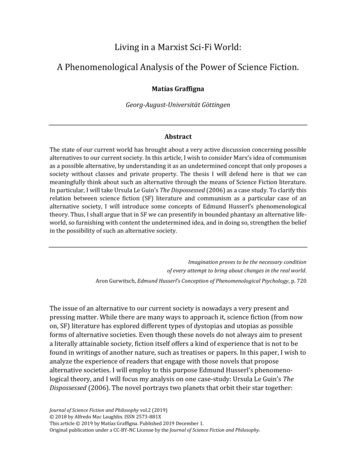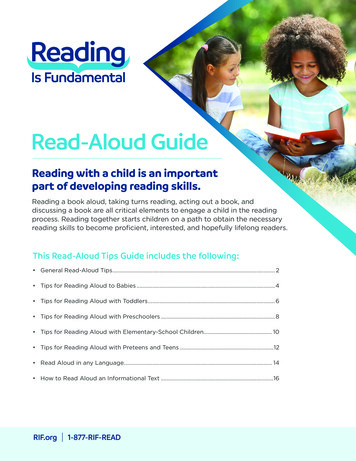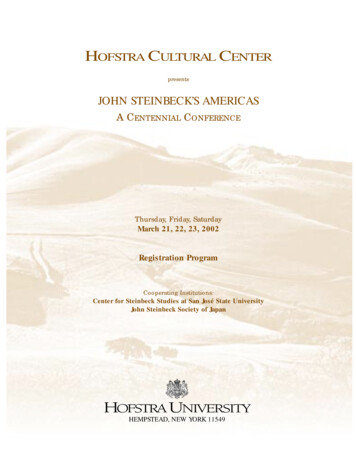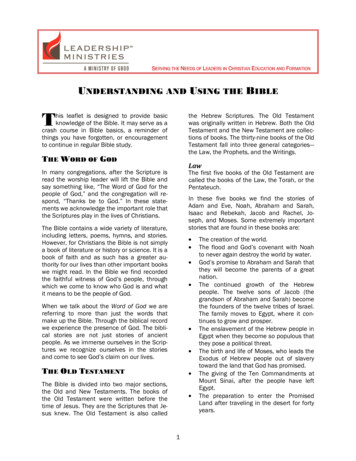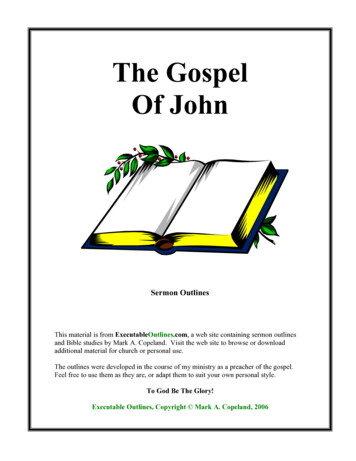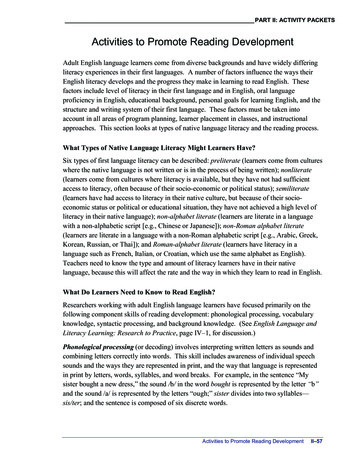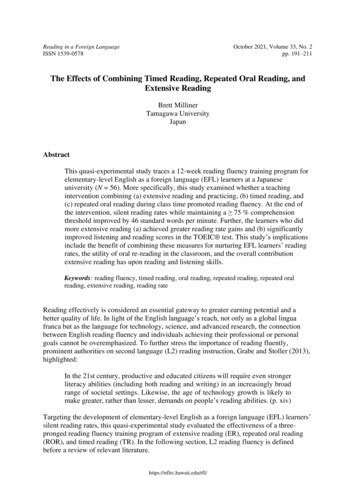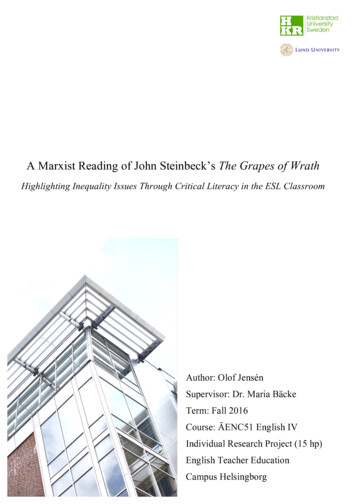
Transcription
A Marxist Reading of John Steinbeck’s The Grapes of WrathHighlighting Inequality Issues Through Critical Literacy in the ESL ClassroomAuthor: Olof JensénSupervisor: Dr. Maria BäckeTerm: Fall 2016Course: ÄENC51 English IVIndividual Research Project (15 hp)English Teacher EducationCampus Helsingborg
AbstractThis essay explores how a critical reading of the novel The Grapes of Wrath (1939) caninform teachers when discussing inequality issues in the ESL classroom. The main questionsbeing investigated are how the novel The Grapes of Wrath reveals oppressive and unequalpower relationships, and how a critical reading of the novel can be used when teaching andinforming others about inequality. In this study, the material is collected through a colorcoding scheme based on a Marxist reading of The Grapes of Wrath. The themes discussed andanalyzed from the novel regard unequal power relationships in terms of exploitation, landownership, the margin of profit, and a struggle between the individual and the group. Inrelation to the literary analysis, practical implications and possibilities for educators arediscussed and considered. A number of conclusions are drawn from the analysis in this study.Firstly, the literary analysis establishes that The Grapes of Wrath indeed can be regarded as acritique of capitalism. Secondly, by making connections to a modern day example ofeconomic crisis, aims in the Swedish curriculum, existing theory of critical literacy, andCritical Literature Pedagogy, the analysis shows clear practical implications for educators interms of using this novel when discussing inequality issues. While this study includes athorough analysis of The Grapes of Wrath and practical implications for educators, it does notcover all aspects of the novel, nor all aspects of working with CLP in the ESL classroom.Keywords: The Grapes of Wrath, Marxist criticism, critical literacy, CLP, ESL
Table of ContentsIntroduction.1Theoretical Background.3Marxism and Marxist Literary Criticism.3Key concepts.3Literary Criticism and The Grapes of Wrath.4Critical Literacy and Critical Literature Pedagogy.5Defining the Method and Data Collection.8Method.8Data collection.8Limitations.9Analysis and Discussion.10Owner Versus Tenant: Property Causing Tension.11Exploitation of The Poor and The Desperate.13The Margin of Profit.17Individualism or Unity? “The I” Versus “the We” .19The Grapes of Wrath, Critical Literacy, and the ESL Classroom.21Practical Implications and Possibilities for Educators.23Conclusion.26Suggestions for Future Research.28References.29
IntroductionThe Grapes of Wrath is one of the most famous, most read, and most criticized novelsever written by an American author (DeMott, 2006, p. i). It was written by John Steinbeckand published in 1939, in the final stage of one of the worst economic crises of the 20thcentury, the Great Depression. In 2008, the world witnessed another, equally severe economiccrisis, very similar to that of the 1930s (Peicuti, 2014). Throughout the world, these financialbreakdowns left millions of people in vulnerable situations, and the ones that were hit thehardest were those already in a weak position (McKay et al., 2010, p. 744). The effects ofthese crises were rapidly felt globally, penetrating every level of society, and are againnoticeable today (OECD, 2013; UNESCO, 2016), which makes inequality an even moreurgent and important issue to discuss for both teachers and students in educational settings.Even so, teachers might feel inclined to ask how a literary analysis can add to theircurrent understanding of teaching literature, which is not surprising since teaching literature issuch a well-established practice in language teaching. It is, in fact, highly likely that educatorswill “be teaching the novel” (Showalter, 2003, p. 88). The answer is not uncomplicated, butone argument is that when adding critical theory to the traditional practice of teachingliterature, students are encouraged to interpret and construct their social worlds in new ways(Tyson, 2015, p. 2). Literary works embody "ways of seeing the world” (Eagleton,1976/2006, p. 3), and in consequence, this means that that critical perspectives offer other,often contrasting views which could support students’ nuanced perspectives of the work andthe world. Adding to that, reading and discussing literature can offer unique opportunities forstudents to develop and feel increased empathy with people in vulnerable and exposedsituations (Koopman, 2016, p. 91).While The Grapes of Wrath offers one perspective on one crisis in one country, its1
descriptions of that crisis delve into much deeper themes and issues at the heart of humannature, and thus, the implications for using this novel are more far-reaching. In the Swedisheducation context, these implications can be linked to national policy documents for theSwedish education system. For example, the National Syllabus for English at upper secondaryschool stresses the need for students “to develop knowledge of living conditions, social issuesand cultural features”, and furthermore that students should be able to think critically andreflect about what they read and hear (Skolverket, “Aim of the Subject,” 2012, par. 2). Theseaims pave the way for a critical literature classroom, guided by Critical LiteraturePedagogy—CLP—which allows students to read not only with, but also against texts(Borsheim-Black, Macaluso, & Petrone., 2014, p. 124). CLP could be guided and furtherenhanced by theoretical perspectives, such as Marxist criticism, which enables students to seeissues of inequality by analyzing and problematizing power structures (Tyson, 2015, p. 2).Hence, there is reason to argue that a critical reading of The Grapes of Wrath couldpotentially inform teachers on how to highlight social issues. By understanding the renewedsignificance that the novel has gained with the economic crisis of 2007-08 (Dyen, 2010), theselection of literary work and theme is motivated in the ESL classroom by an increasedimportance of focusing on injustice in society. In accordance, this essay seeks to criticallyexamine the novel The Grapes of Wrath by John Steinbeck from a Marxist perspective, inorder to explore and consider practical implications for using this novel when discussinginequality issues in a classroom setting. In addition, because this study is interdisciplinary, itwill simultaneously focus on the following questions: How might The Grapes of Wrath be seen as a critique of capitalism? That is, in whatways do the text reveal, and invite us to condemn, oppressive socioeconomic forces?Adapted from Tyson (2015, p. 65). How can the ideas and information developed in reading with and against The Grapes ofWrath be used to inform, persuade others about oppression and injustice? Adaptedfrom Borsheim-Black et al. (2014, p. 127).2
Theoretical BackgroundIn this section, the theoretical foundation of this essay and its analysis will be presentedand discussed. In the following, we will first look at Marxism and Marxist literary criticism.Next, the focus will briefly fall on previous analyses in relation to the novel The Grapes ofWrath. Finally, the definitions and background of critical literacy and CLP will be presented.Marxism and Marxist Literary CriticismMarxist literary criticism has grown from the theoretical body of Marxism and thewritings of Karl Marx and Friedrich Engels, and through Marxist criticism, literature isanalyzed by interpreting and focusing on the historical context in which it was written(Eagleton, 1976/2006; for an example of a Marxist reading of a literary work, see Davari,2015). Furthermore, Marxist criticism is, according to Eagleton (1976/2006), "essential forthe fullest explanation of any work of literature" (p. 4), meaning that Marxism as a theoreticalframework is useful and relevant when analyzing literature in the classroom.Key concepts. In order to be able to apply Marxist criticism on literary works,fundamental concepts such as capitalism, socioeconomic class, ideology, consumerism,rugged individualism, and Marx’s labor theory of value are crucial. In short, for Marxists,capitalism is an ideology that gives rise to inequality in the world, and human inequality is aresult of capitalism's structure where "the means of production are privately owned and those who own them inevitably become the dominant class" (Tyson, 2015, p. 55). BecauseMarxist critics essentially are concerned with how capitalism divides people into differentclasses, they mainly make the distinction between two groups: "the 'haves' and the 'havenots'” (p. 52). Therefore, a Marxist would argue that depending on which socioeconomic classa person belongs to, he or she is in possession of different grades of “[e]conomic social andpolitical power” (p. 51). In order for capitalism to flourish and prosper, consumerism is a3
driving force, as it changes our relationship to commodities. According to Marx, the profit ofthe owners—the capitalists—are “based on the exploitation of the laborer” (Ritzer, 2011, p.24), which is what is known as the labor theory of rule. Capitalists are concerned with theirown well-being, which comes at the cost of the society at large, and thus, they are ruggedindividualists (Tyson, 2015, p. 57).Literary Criticism and The Grapes of WrathThe Grapes of Wrath has since its publication been widely discussed and analyzed.The existing body of research and analysis of the novel is very diverse, but one of the mostwidely discussed topics of the novel is its symbolism, and Christian symbolism in particular(eg. Fontenrose, 1964; Kawata, 2001; Lisca, 1958; Rombold, 1987; see also Delucia, 2014 forclass symbolism). In contrast, other scholars have focused on John Steinbeck as a writer ofsocial change (eg. Cunningham, 2010, Dickstein, 2004; Yee, 2013), and on the reactions tothe publication of the novel (eg. Weisiger, 1992; Welsch, 2010).In order to support our understanding of the vast amount of analysis and critiquebestowed upon this novel, we will briefly return to the previous notion of initial reactions tothe novel. The fact is that upon its publication in 1939, the novel gave rise to a wide range ofcritical responses, targeting everything from the much too vulgar language and descriptions inthe novel, to the supposedly misleading descriptions of migrant families, meant to increasesympathy for these families (Welch, 2010, p. 90). However, not only did the novel catch theattention of literary critics, but also of the larger population, especially those described in thenovel, “the Okies” (p. 92). Conversely, the novel was also praised for its "powerful call forunity, compassion, and justice" (p. 91).While it is clear from what was presented above that The Grapes of Wrath is a work thathas caught the interest of many scholars, and despite the fact that it is one of the most read4
American novels of all time, next to nothing has been written on the novel in relation toeducation and teaching. Therefore, the primary task of this study will be to combine a criticalreading of the novel with practical implications for teachers, and in consequence, it is relevantto shed light on potential modes of procedure for integrating a critical reading of the novel ina classroom context.Critical Literacy and Critical Literature PedagogyDefining the concepts. Borsheim-Black et al. (2014) familiarize us with the conceptof Critical Literature Pedagogy—CLP—which is "a pedagogical framework for merginggoals of critical literacy with canonical literature instruction" (p. 123). CLP is interesting herebecause when one applies critical literacy to canonical literature, one questions and furtherexplores contemporary ruling ideologies upheld or undermined by such literature (p. 124).Furthermore, critical literacy, as a part of CLP, brings many advantages to the classroom,where one prominent feature is its capability to improve students' ability to "read and writeagainst texts" (p. 123). This means that critical literacy makes students aware of ideologicaland political elements of texts, and teaches them to analyze their everyday life. Moreover,critical literacy can, as explained by Lewison, Seely Flint, and Van Sluys (2002), havemultiple areas of utility, since it can be used for "Disrupting the Commonplace","Interrogating Multiple Viewpoints", "Focusing on Sociopolitical Issues", and "For TakingAction and Promoting Social Justice" (p. 383).Limitations. While the positive effects of pairing critical literacy with teachingcanonical literature are evident, Borsheim-Black et al. (2014) indicate difficulties in doing soin practice due to lack of previous best practice research to build on (p. 124). Furthermore,such difficulties could include, as Ko and Wang (2009) identified in their study of teachers'perceptions of critical literacy in the classroom, that students are not able to make use of5
critical literacy due to limited proficiency and autonomy (p. 189). On the contrary, Ko andWang’s (2009) results also showed that teachers had a desire and intention to use criticalliteracy when possible, yet with caution due to a fear of overstepping political boundaries (p.182). These notions give evidence in favor of a perception of critical literacy as a foreign, andtherefore frightening concept to integrate in the classroom. Thus, a possible course of actionto take in order to overcome such obstacles should be considered.Implications. Despite these challenges, CLP combines "[reading] with and against atext" (Borsheim-Black et al., 2014, p. 124), making it an applicable tool for language teachers.Reading with a text is what most would consider a traditional practice of teaching literature,while reading against a text is about identifying and questioning ideologies of literary worksand written texts (p. 124). Although it is easy to "see these two ways of reading asdichotomous", i.e. reading with and against a text, Borsheim-Black et al. (2014) argue that"learning to read with might be seen as necessary to be able to read against" (p. 125). Thisview is supported by Huh (2016), who found that mixing and combining traditional literacypractices with critical literacy practices can convey very positive effects. From a study ofintegrating critical literacy in his own teaching, Huh (2016) concluded that "[i]n students'engagement with critical literacy practices, they demonstrated strong comprehension of thereading texts" (p. 232). Another quality of applying critical literacy when teaching canonicalliterature is not only that it questions the ideological elements of literary works, but also that itexamines why a work has come to be canonized to begin with (p. 125).Before moving on, it is relevant to consider some more arguments in favor of a criticalliteracy classroom. Beach, Appleman, Hynds, and Wilhelm (2011) suggest that teachingliterature is about more than just teaching literature as a way of teaching "our culturalheritage" (p. 153). Instead, teaching literature should also support students' understanding ofthe "social, political, and cultural contexts that shape their lives" (p. 153), and hence, the6
function of critical literacy is to make visible elements of ideology in literary works and in thecontexts of students’ everyday lives. Based on Beach et al.’s conception of what teachingliterature essentially should be, critical literacy is not just an optional tool for teachingliterature, but rather a necessity to ensure that students’ are equipped with the right skills andqualities to be able to critically, and in a nuanced way analyze their world.7
MethodologyIn this section, the methodology will be presented. Here, the modes of procedure fordata collection will be described, along with the limitations of the method of this study,limitations of the theoretical foundation, and limitations of the study as a whole.Method and Data CollectionMethod. The material in the analysis will be gathered through a color-coding scheme,as suggested by Zhang and Wildemuth (2009). While the coded themes have emerged fromreading the novel, the critical reading has been informed by previous research and Marxisttheory, in accordance with Zhang and Wildemuth’s (2009) argumentation of a combinationbetween inductive and deductive reasoning while working with qualitative content analysis(p. 3). Furthermore, this study is both quantitative and qualitative in character in that itcombines working from the hypothesis that the novel is a critique of capitalism, while alsooperating inductively to generate themes from the novel (Zhang and Wildemuth, 2009, p. 1).In addition, because this study attempts to verify, but also to add to existing theory andresearch on the subject, the analysis is directed in character (Hsieh & Shannon, 2005, p.1281). Yet, this study is also conventional in that previous findings and theories are includedand compared in the discussion (Hsieh & Shannon, 2005, p. 1279).Data collection. During the first reading of the novel, themes and passages that couldbe related to the novel as a capitalist critique were highlighted. During a second reading, allthe highlighted passages were grouped and categorized with colors according to the followingthemes: exploitation (blue), tensions in land ownership (green), the margin of profit (yellow),and “we” versus “I” (red). The relevant passages with page numbers were subsequentlyarranged in a table according to category. While many interesting and potentially relevantpassages emerged from the analysis, only the most central extracts that fitted into one of the8
four categories were chosen to analyze further. This was done in order to make sure that the“information [ ] correspond[s] to the aim” of the study (Bengstsson, 2016, p. 12).Limitations. The method and theoretical foundation of this study entail certainlimitations which are crucial to point out. Firstly, it is necessary to note that this study makesno claims to portray how Marxist criticism and CLP can be used generally, but merely offersthese perspectives in relation to one literary work. Furthermore, Marxist criticism is onetheoretical framework among others, such as Feminist criticism, and while Marxist criticismis a far-reaching theoretical framework, this study does not cover all aspects of Marxistcriticism. Moreover, it should be noted that a majority of the questions presented throughoutthe analysis are not explicitly answered in this study, and that their function primarily is to beused as questions for reflection and consideration for readers and teachers. Moreover, becausequalitative content analysis, which is the data collection method for this study, relies much oninterpretation, there is necessarily a high grade of subjectivity in this study (Bradley, 1993;Hsieh & Shannon, 2005; Nunan, 1992). In terms of Bradley’s (1993) notion of transferability,this study is limited due to its narrow focus on one written work and one school system in theworld. Nevertheless, the transferability of this study is best estimated by others attempting todo similar studies.9
Analysis and DiscussionThe analysis in this study consists of six different sections with four different themesfrom the novel. The analysis will both be based on the narrative chapters that follow the fateof the Joad family, and the interchapters “which suggest how to interpret both the story andthe social world” (Cunningham, 2010, p. 345). Thirteen of the interchapters “serve to amplifythe action created by the Joad family”, and three chapters focus on adding historicalinformation (Lisca, 1958/1972, p. 84). After the first four sections, two sections will followwith considerations and practical implications for teachers. Before we begin analyzing thenovel, a very brief overview of the historical context in which the novel was written will beincluded, drawing on Cunningham (2010).The Grapes of Wrath was written in the final stages of the Great Depression, and is,according to Cunningham (2010), “an exemplary radical analysis of the exploitation ofagricultural workers” (p. 329). The migration that is depicted in the novel was triggered bystorms that caused the land in ‘the Great Plain States’ to become hopeless, or impossible, tocultivate (p. 331), but the bad circumstances for the agricultural workers were aggravated byseveral other factors:The Depression exacerbated the collapse because the non-agricultural industries of theurban areas slowed down considerably, greatly hindering the absorption of displacedagricultural workers. The land retirement policies of the Agricultural Adjustment Act(AAA) furthered that displacement, as did the mechanization of farming, which wasmore pronounced in the Southwest than in the old South. (Cunningham, 2010, p. 333)While the determining factors listed above are not always explicitly referred to in the novel,many of the themes and ideas that are presented and problematized in the novel and in thisanalysis can be directed to these economic, social, and political circumstances.10
Owner Versus Tenant: Property Causing TensionOne very central conflict that was intensified by the previously mentionedcircumstances was the tension between landowners, and tenants, and workers. In the novel,we quickly come to see that the Joad family has been evicted off their land and have joinedthe migration movement westward. Yet, because they have received a hand bill stating thatthere is plenty of work in California (Steinbeck, 2006, p. 90), a predominantly positive viewemerges from the first part of the novel regarding what land-owning will be like in the newcountry. For example, Ma Joad dreamingly describes how she longs for California with“people just bein’ in the happiest places”, living in “white houses in among the orange trees”(p. 91). Similarly, Pa Joad still talks of the Promised Land when the Joads have alreadycrossed the border to California (p. 204). Unlike Ma and Pa, however, Tom is not as naïve asto ignore the warning signs in the stories about how it is really like in California. In the sameway that Tom reminds Ma of what he has heard about the miserable conditions of migrantworkers in California (p. 92), he tells Pa that “Jesus Christ, Pa! This here is California.”(Steinbeck, 2006, p. 204).Pa and Ma’s views are not unique because, as Cunningham (2010) explains, “[i]f themigrants began with dreams of sharing the wealth of the great agricultural valleys byeventually becoming small landowning farmers, what they found was an entrenched corporateagribusiness that mocked agrarian myths” (p. 334). Tom’s misgivings are confirmed by whatthe Joads ultimately meet when they set out to find work in California, which is that the landthere, like back home, is owned by big corporate bodies. Still, while the story takes its startingpoint with the Joad family, who abandon their farm and set out on the road from a Dust Bowlstate, the novel delves into much more complicated themes of land-ownership andexploitation. As the story evolves, we see that the land ownership relationships are muchmore complex than the over-simplistic explanation that land owners simply exploit11
agricultural workers. Instead, what we come to realize through examining land ownership inthe novel, is that Steinbeck “attacks the logic and consequences of private property itself”(Cunningham, 2010, p. 346).The critical standpoint on land ownership taken in the novel is clear when Pa and Tom,upon the Joads’ arrival in California, speak to a man who explains the situation in California:[s]he’s a nice country. But she was stole a long time ago. [ ] you can’t have none ofthat lan’. That’s Lan’ and Cattle Company. An’ if they don’t want ta work her, she ain’tgonna git worked. You go in there an’ pant you a little corn, an’ you’ll go to jail!(Steinbeck, 2006, p. 205)Pa, confused and bewildered by the man’s explanation, goes on to ask whether there are anypositive sides to it. The man continues: “Sure, nice to look at, but you can’t have none of it.They’s a grove of yella oranges-an’ a guy with a gun that got the right to kill you if you touchone” (Steinbeck, 2006, p. 206). When the man describes that “she [the land] was stole a longtime ago” (p. 205), he refers to how the land once was occupied and claimed, which weunderstand from chapter nineteen.In chapter nineteen, the view expressed in the passage above is reinforced when readersare more closely familiarized with the development of land ownership in California. Thedescription reads that land that once belonged to Mexicans has been occupied and made intopossession by profit seeking Americans (Steinbeck, 2006, p. 231). Furthermore, thispossession has developed farming into a business that can only be counted in money, and withtime the farmers have grown fewer and they have become bureaucrats that hire other men tofarm their land (p. 232). Moreover, an interesting notion is that this passage has been noted asone of the few places in the novel with mention of non-white migrants and their history(Cunningham, 2010, p. 343).What makes chapter nineteen of relevance here, however, is that it enables us tounderstand how land ownership transitions have formed the present. A similar mechanism is12
displayed in chapter twenty-one, where the fates of small scale fruit growers are comparableto those of other farmers in the novel: they are forced to succumb to the big owners of thecanaries and leave their land (Steinbeck, 2006, p. 284). Still, the relationships between theowners of the land and the workers of the land are more complicated, which is demonstratedwhen Tom Joad, upon his arrival at the government camp, goes along with two men who arealready employed to get a job. Their employer informs them that he has to cut their wage by 5cents due to pressure from “the Farmers’ Association” and “The Bank of the West” (p. 294).The same view that is given in chapter nineteen is confirmed here, where we see that whilethe men and Tom are migrant workers at a farm, it is not the farmer himself that exploitsthem, but rather the association and the bank. Similarly, when Ma Joad meets a man lookingfor workers to pick cotton on his farm, he tells her that the wages are out of his control, andthat “[t]he association sets the rate, and we got to mind. If we don’t—we ain’t got a farm.Little fella gets crowded all the time” (p. 421).The highlighted passages demonstrate a clear tension of land ownership betweendifferent classes, which leads readers to reflect over what it is that substantiates this view ofland ownership as a natural right. Within a capitalist system, one of the very cornerstones isthe God-given right to own property (Tyson, 2015, p. 54), which certainly gives rise to intensereactions when land is ‘stolen’ from a person or a group claiming to own that land. In TheGrapes of Wrath, the issue of land ownership is presented as so problematic as to be one ofthe underlying reasons for the severe situation of the poor and the vulnerable.Exploitation of The Poor and The DesperateWhile the issue of land ownership presented in the previous section is not labeled hereas exploitation, its fundamental conflict is intensified by other, more explicit notions of13
exploitation in the novel. Key to understanding exploitation here is that the drive for “theaccumulation of more and more capital” depends on increased exploitation (Ritzer, 2011, p.62). In the novel, we are mainly familiarized with two kinds of exploitation thatfundamentally work under the same mechanisms. On the one hand, we see how the poor areexploited through trade, and on the other hand we see how migrant workers are mistreatedbecause the owners of the farms are conscious and
The Grapes of Wrath is one of the most famous, most read, and most criticized novels ever written by an American author (DeMott, 2006, p. i). It was written by John Steinbeck and published in 1939, in the final stage of one of the worst e
